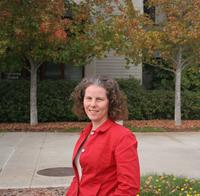UCSD Wireless Expert Named IEEE Fellow
San Diego, CA, December 12, 2007 -- For her contributions to image and video compression and wireless communications, UCSD electrical engineering professor and Calit2 participant Pamela Cosman has been elected an IEEE Fellow. Cosman is the Director of the Center for Wireless Communications (CWC) at the Jacobs School of Engineering and editor-in-chief of the IEEE Journal on Selected Areas in Communications.
|
“I do quite a bit of research in the area of wireless video. Part of that is straight compression algorithms and part of that is compression algorithms combined with error correction coding – because when you transmit wirelessly there are a lot of different losses that occur,” said Cosman, who has been a co-principal investigator on Calit2's Ericsson-sponsored Adaptive Systems project since 2002.
“I have looked at many different aspects of the challenge of making video compression error resilient – so that your signal doesn’t collapse completely from one error. I have also investigated ways that the decoder can conceal loss-related errors from the viewer.”
You can read more background from Cosman on decoders, encoders and the challenges of video compression in a wireless environment here.
When asked about future trends, Cosman said, “I think one of the big things is going to be scalable video – where transmitted video can be flexibly rescaled for different spatial resolutions, different temporal resolutions and different complexity levels depending on what kind of device is going to receive them.”
Cosman also pointed out the rising interest in relays – small devices that can be widely distributed and serve to pass wireless signals through walls or other obstructions. “Relays may be rescaling the signal or changing the amount of error correction redundancy or doing other things to the video stream to optimize it for specific channel conditions or for whatever the final device is going to be,” said Cosman.
Another fixture of our technological future, according to Cosman, will be an increased prevalence of cameras.
“I think cameras are going to be all over the place, for medical applications, home monitoring, surveillance, security applications, manufacturing, agricultural inspection…all kinds of things. I think cameras are going to be absolutely pervasive in the world around us. Looking at everything. Interpreting everything. Transmitting information all over the place,” said Cosman.
With cameras everywhere, the amount of data collected will be tremendous. It will be important for computers to automatically figure out what is in the data, interpret the video and distill the key elements. For example, is there a person walking in this scene or not? Is the fruit ripe or not?
“You want to distill it down to a little piece of information rather than storing all the raw pixels,” said Cosman.
Early in her career, Cosman worked on quality evaluation of compressed medical images. Radiologists were asked to look at either compressed or original medical images and make diagnoses. Cosman wanted to see if the compression affected the diagnostic outcome. “This early work had a big effect on research that other people were doing, and my research was presented to the Food and Drug Administration when they were contemplating the use of compression in medical imaging devices.”
When asked what advice she would give high school students thinking about majoring in engineering, she said, “It’s really important to do well in math. Everything is built so hierarchically on the math foundation. As a high school student, you need to be very solid on that or you’re going to have a hard time later on.”
Cosman also responded to the question, How do you know if engineering is going to be a good match for you?
“It’s often hard to tell if engineering is something that is for you. As a college freshman you’re not taking a whole lot of actual engineering classes. You’re mostly doing your basic math and physics and so it takes a while to get into it to see if you like it. I think it would be helpful to meet some working engineers and talk to them and find out what people do all day long in their jobs. It is also useful to talk to different kinds of engineers because even within just electrical engineering there is enormous variety in what people are doing. And certainly when you look at other kinds of engineering, the spectrum is vast. I think a lot of people don’t realize just how big and varied engineering is. They think of engineering as sort of one unified thing where everyone is doing similar jobs. It’s not at all like that.”
Cosman joined the UC San Diego Jacobs School of Engineering faculty in July of 1995. Prior to coming to UCSD, she was a Visiting Assistant Professor of Electrical Engineering at the University of Minnesota, and a postdoctoral fellow and lecturer with the Information Systems Laboratory at Stanford University. Cosman earned a Ph.D. from Stanford University in 1993 and a B.S.E.E. from the California Institute of Technology in 1987.
As the Director of the Center for Wireless Communications, Cosman directs an industrially supported group of UCSD professors who do research on all aspects of wireless communications including communication theory, networking, RF circuits, antennas and propagation, and multimedia. The CWC primarily operates within the Department of Electrical and Computer Engineering, with some participation from the Department of Computer Science and Engineering.
Related Links
Pam Cosman's Web page
Video Interview with Pam Cosman
A video compression primer from UCSD
Center for Wireless Communications
IEEE Journal on Selected Areas in Communications
Media Contacts
Media Contact: Daniel Kane, Jacobs School of Engineering, 858-534-3262, bkane@ucsd.edu

